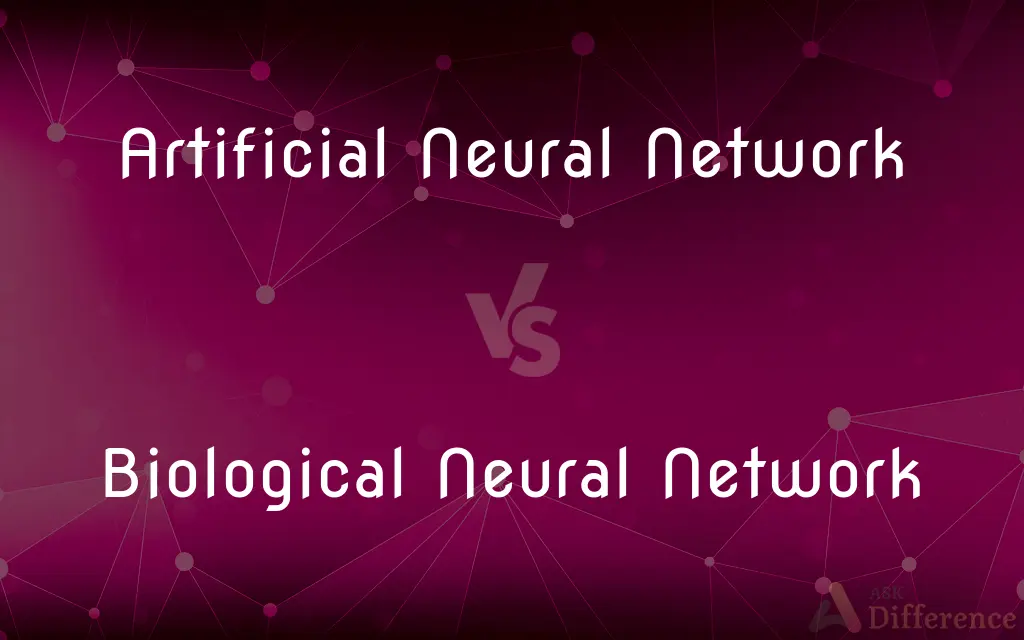Artificial Neural Network vs. Biological Neural Network — What's the Difference?
By Tayyaba Rehman — Published on January 9, 2024
Artificial Neural Networks are computer models designed to mimic brain functioning, while Biological Neural Networks are the actual neural networks in living organisms.

Difference Between Artificial Neural Network and Biological Neural Network
Table of Contents
ADVERTISEMENT
Key Differences
Artificial Neural Networks (ANNs) are computational models inspired by the human brain, used in machine learning and artificial intelligence. They consist of interconnected units or nodes that process information using a connectionist approach. Biological Neural Networks, on the other hand, are composed of real neurons in biological organisms. These networks are responsible for processing and transmitting information through electrical and chemical signals.
ANNs are designed to simulate how a biological brain solves problems, with layers of artificial neurons learning from large amounts of data. These models are typically used in applications like pattern recognition, decision making, and predictive modeling. In contrast, Biological Neural Networks naturally evolved in living organisms, forming the basis of the nervous system, enabling senses, movement, cognition, and other biological functions.
The architecture of ANNs often includes input, hidden, and output layers with adjustable weights and biases, allowing the network to learn and make predictions or decisions based on input data. Biological Neural Networks consist of a complex arrangement of neurons, synapses, and neurotransmitters, which work together to process information organically and dynamically.
In terms of learning, ANNs require training with large datasets and algorithms to adjust and optimize their function. This process is often resource-intensive and time-consuming. Biological Neural Networks learn and adapt continuously through natural processes like synaptic plasticity, driven by stimuli and experiences.
The primary difference lies in their composition and function: ANNs are artificial constructs with limitations based on current technology and understanding of neuroscience, while Biological Neural Networks are naturally occurring, highly complex systems that are not yet fully understood.
ADVERTISEMENT
Comparison Chart
Composition
Computer-based, interconnected artificial units
Natural neurons and synapses in living beings
Function
Data processing, pattern recognition, predictions
Processing sensory information, controlling bodily functions
Learning Method
Trained using algorithms and data sets
Natural adaptation through experiences and stimuli
Structure
Layers with adjustable weights and biases
Complex networks of neurons and synapses
Applications
Machine learning, AI, predictive modeling
Sensory processing, movement control, cognitive functions
Compare with Definitions
Artificial Neural Network
They simulate neural processing in a simplified, artificial form.
Self-driving cars use ANNs for processing sensor data.
Biological Neural Network
Evolved to enable cognition, senses, and reflexes.
Reflex actions are governed by the spinal cord’s neural network.
Artificial Neural Network
Used widely in AI for pattern recognition and decision-making.
ANNs power recommendation systems in e-commerce platforms.
Biological Neural Network
Adapts and learns naturally through stimuli and experiences.
Learning a language involves the brain’s neural network.
Artificial Neural Network
ANNs learn and adapt through training and data analysis.
ANN algorithms are applied in predictive analytics.
Biological Neural Network
A biological neural network is the brain's natural information processing system.
The human brain’s neural network is essential for memory formation.
Artificial Neural Network
It consists of layers of interconnected artificial neurons.
Deep learning utilizes ANNs for image classification.
Biological Neural Network
Comprises actual neurons and synapses in living organisms.
Biological neural networks control muscle movement.
Artificial Neural Network
An ANN is a computational model mimicking brain function.
ANNs are used in facial recognition software.
Biological Neural Network
Processes information through electrical and chemical signals.
Sensory information is processed through biological neural networks.
Common Curiosities
How do Artificial Neural Networks learn?
They learn through algorithms, adjusting based on input data and desired outcomes.
Can Artificial Neural Networks function like a human brain?
They simulate brain functions but are not as complex or adaptable as a human brain.
What roles do Biological Neural Networks play in the body?
They process sensory information, control movements, and enable cognitive functions.
What is an Artificial Neural Network?
It's a computer-based model designed to mimic the human brain's information processing.
How do Biological Neural Networks process information?
They use electrical and chemical signals to transmit and process information.
What constitutes a Biological Neural Network?
It consists of neurons and synapses in living organisms, facilitating various biological functions.
Do Biological Neural Networks change over time?
Yes, they adapt and change based on experiences and stimuli.
Are Biological Neural Networks involved in reflex actions?
Yes, they are essential for reflexes and involuntary responses.
How are Artificial Neural Networks trained?
They are trained using large datasets and iterative learning algorithms.
What industries use Artificial Neural Networks?
They're used in tech, healthcare, finance, and more for predictive modeling and AI solutions.
Can Artificial Neural Networks evolve like Biological Neural Networks?
They can adapt and improve but don't evolve organically like biological networks.
Can Artificial Neural Networks replace human decision-making?
They assist in decision-making but can't fully replicate human judgment and ethics.
Are there ethical considerations in using Artificial Neural Networks?
Yes, ethical considerations include data privacy, bias in decision-making, and AI accountability.
What's the complexity level of Artificial Neural Networks compared to Biological Neural Networks?
Biological Neural Networks are far more complex and dynamic.
Do Biological Neural Networks use electrical signals?
Yes, they process information using electrical and chemical signals.
Share Your Discovery

Previous Comparison
Peppermint Oil vs. Peppermint Extract
Next Comparison
True Solution vs. Colloidal SolutionAuthor Spotlight
Written by
Tayyaba RehmanTayyaba Rehman is a distinguished writer, currently serving as a primary contributor to askdifference.com. As a researcher in semantics and etymology, Tayyaba's passion for the complexity of languages and their distinctions has found a perfect home on the platform. Tayyaba delves into the intricacies of language, distinguishing between commonly confused words and phrases, thereby providing clarity for readers worldwide.













































